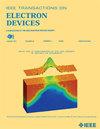Unveiling Ferroelectric HZO Cryogenic Performance (4–300 K): Kinetic Barrier Engineering and Underlying Mechanism
IF 2.9
2区 工程技术
Q2 ENGINEERING, ELECTRICAL & ELECTRONIC
引用次数: 0
Abstract
In this work, we perform comprehensive and in-depth investigation of the cryogenic characteristics of ferroelectric (FE) hafnium zirconium oxide (HZO) thin films with varying thicknesses (3/5/7/10 nm) across a broad temperature range (揭示铁电HZO低温性能(4-300 K):动力学势垒工程及其机制
在这项工作中,我们在广泛的材料和电学表征的帮助下,在广泛的温度范围($4\sim 300$ K)内,对不同厚度(3/5/7/10 nm)的铁电(FE)铪锆氧化物(HZO)薄膜的低温特性进行了全面和深入的研究。我们发现:1) 3和5 nm HZO电影表现出明显的温度依赖性残余偏振($ {P} _{\文本{r}} $)和强制字段($ {E} _{\文本{c}} $)比7和10 nm的由于不同的相变机制和2)氧气的浓度和位置空缺充当关键影响因素固定效应以及trap-assisted-tunneling过程,从而影响了与温度有关的行为的$ {P} _{\文本{r}} $和$ {E} _{\文本{c}} $。基于这些见解,我们提出并实验证明了一种创新的低温屏障工程方法,用于增强${P}_{\text {r}}}$,特别对超薄HZO薄膜有价值。
本文章由计算机程序翻译,如有差异,请以英文原文为准。
求助全文
约1分钟内获得全文
求助全文
来源期刊

IEEE Transactions on Electron Devices
工程技术-工程:电子与电气
CiteScore
5.80
自引率
16.10%
发文量
937
审稿时长
3.8 months
期刊介绍:
IEEE Transactions on Electron Devices publishes original and significant contributions relating to the theory, modeling, design, performance and reliability of electron and ion integrated circuit devices and interconnects, involving insulators, metals, organic materials, micro-plasmas, semiconductors, quantum-effect structures, vacuum devices, and emerging materials with applications in bioelectronics, biomedical electronics, computation, communications, displays, microelectromechanics, imaging, micro-actuators, nanoelectronics, optoelectronics, photovoltaics, power ICs and micro-sensors. Tutorial and review papers on these subjects are also published and occasional special issues appear to present a collection of papers which treat particular areas in more depth and breadth.
 求助内容:
求助内容: 应助结果提醒方式:
应助结果提醒方式:


